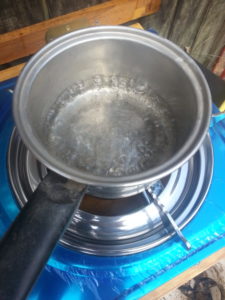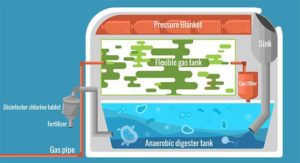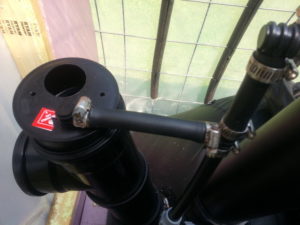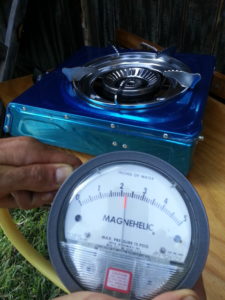My enlightenment on the subject of biogas began when I stumbled upon an article in a dog-eared copy of The Mother Earth News entitled “Chicken Manure Can Power Your Car.” Buried among debatable bootstrap business stories and homespun garden-prep tutorials, the write-up recounted how a one-legged British maintenance man named Harold Bate converted a 1953 Hillman sedan to run on decomposing poultry waste to circumvent what he saw as an unreasonably high tax on gasoline.
At the time I didn’t realize that not too far into the future I’d be building and operating a similar methane digester at the very same publication that ran the story years before. I’d been hired by the magazine and almost immediately thrust into the development of a 624-acre research farm in the mountains of Western North Carolina, where biodynamic gardening, permaculture, alternative energy, and natural building were the rule, not the exception. The experience left me with a newfound appreciation for the convenience of petroleum fuels–but it also opened a vast world of unexplored alternatives.
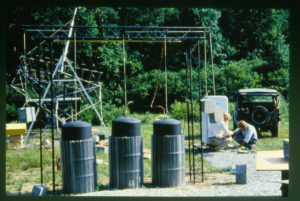
My earliest foray into biogas, setting up a Servel gas refrigerator to run off the biogas generating tanks in foreground
There’s probably no better time than the start of the Spring season to talk about methane digestion—now referred to as “biogas” to more accurately describe its place in the hierarchy of renewable energy. Spring is nature’s time for rebirth and renewal, and the decomposition process of turning waste into a new form, a burnable fuel, is not so far removed.
The Living Web Farm project began in 2018 when we agreed to set up and test the Home Biogas system, a small home and farm scale anaerobic digester manufactured by a startup collaborative in Beit Yanai, Israel. Unlike more permanent systems, this one uses a reinforced flexible bag as a digestion tank and a second sealed chamber as a gas storage bag. A molded plastic inlet feed sink is attached at one end and liquid fertilizer outlet at the other, with a gas filter and management setup fastened to the gas storage chamber.
This approach makes it fairly easy to set up and operate a gas-generating system as long as you have raw materials available to feed it. This would include animal manures, food wastes, and garden culls such as vegetables, fruits, and even meat and fats. So let’s take a look at how it works.
What is Anaerobic Digestion?
In the short version, it’s a natural process in which organic materials decompose in the absence of atmospheric oxygen. Unlike aerobic digestion, familiar to most of us as simple composting, the anaerobic process involves specialized microorganisms known as methanogens whose metabolism generates methane in low-oxygen conditions. Because they do not have access to surrounding air, their limited oxygen requirements are derived from the organic material itself.
The transition from organic material to gas occurs in four stages. The first is hydrolysis, in which a watered slurry breaks down chemical bonds in complex matter such as carbohydrates and proteins into simple molecules of sugar and amino acids. The second stage is acidogenesis, by which those molecules are converted into ethanol and fatty acids, creating carbon dioxide and hydrogen sulfide coproducts. In the third phase, the ethanol and fatty acids transition to hydrogen and acetic acid in a process called acetogenesis. Finally, in the fourth stage the methanogenic organisms prevail to convert remaining hydrogen and acetic acids into methane and additional carbon dioxide. The composition of biogas is typically 55 to 65% methane and 35 to 45% CO2, with traces of nitrogen, hydrogen, water vapor, and hydrogen sulfide. The last two components are stripped out with a condensation trap and ferrous filter to improve the quality of the gas.
Fortunately for us, this complex series of events occurs without our intervention, save for providing a hospitable environment and a regular ration of feedstock material. Hosting the accommodations essentially means maintaining a consistent temperature above 75 degrees F and monitoring the slurry chamber’s pH levels. A surprising variety of kitchen and garden wastes, and animal manures, can successfully contribute to the generation of methane gas, but too much of certain things will crash the pH balance, dropping the levels into acidic territory and requiring a minor course of stabilization.
Even if the temperature falls below the threshold or pH levels stray from the ideal neutral zone, it does not kill the gas-producing organisms; they will simply go dormant until corrections are made and they can continue on their natural path. Extreme cases of pH imbalance will render populations inactive, in which case they can be easily jump-started with an infusion of fresh manure.
Why Bother?
Before I answer that, I want to answer this: Methane is a greenhouse gas. Why would we want to make more of it? The short answer is that livestock manures (among other things) generate methane whether we intervene or not. Here we are simply making and capturing it in a controlled fashion. Allowing it to degrade in the environment causes direct atmospheric emissions, the second greatest source of GHGE in intensive dairy operations. Coincidentally, volatized ammonia from concentrated livestock manures becomes residual in water and land ecosystems and can subsequently convert to nitrous oxide emissions as well.
But back to the question: we do it because energy provided by biogas can replace its share of fossil fuel, which happens to be the prime contributor to greenhouse gas emissions. Biogas energy is considered carbon neutral, since carbon emitted when burning it comes from the carbon fixed by plants in their biological cycle.
Biogas energy can be a supplementary source of income on a larger scale, but for small-potatoes producers it could reduce or eliminate the need for a propane delivery or a natural gas hookup. It can be a source of cooking, heating, or lighting fuel in any location, on or off-grid, and its residual digested matter can be further composted to provide nutrients to garden soils.
Granted, biogas does not have the energy content of natural gas. Due to a lower methane component, it contains about 25% less energy in Btu’s per unit, but it is has the advantage of being renewable and does not have to be extracted from the ground. Each cubic foot of biogas contains about 600 Btu’s of energy, so the standard measure of one cubic meter (35 cu. ft.) provides 21,000 Btu’s or the equivalent of 6 kW hours of heat energy–enough to keep a cookstove burner going for 4 to 7 hours (depending on its size) or a 100-watt light bulb on for 60 hours.
Post-Digestion Particulars
The amount of waste going into the digester is almost equal to the amount coming out. But the quality of that residue is improved with far less odor and a higher quality fertilizer because the nitrogen in the effluent is more readily absorbed by plants than the nitrogen contained in raw manure. Its nutrient value remains nearly as complete. Liquid effluent can be drained off and used as fertilizer; the solid component is removed periodically and is normally composted.
Through the anaerobic digestion process, most disease vectors are destroyed and external odors are eliminated, resulting in an impressive level of insect control. In fact, the only odors present in a healthy system exhibit as a slightly musty scent and are contained in the digestion tank itself, which is sealed from the outside environment.
The Need to Feed
As I mentioned earlier, hosting a biogas digester requires maintenance heat, pH balance, and a third condition familiar to home composters–a favorable Carbon to Nitrogen ratio.
Although reaction temperatures as low as 75 degrees F will keep the system functioning, ideal mesophilic conditions occur closer to 95 degrees. At this level, volume production and efficiency are optimized, and retention time can be as low as 15 days. The digester at Living Web is currently housed in a small greenhouse enclosure where it sees direct solar gain throughout the year. In the winter months, endwall and subfloor extruded polystyrene insulation works to retain some of the heat, but a 300-watt internal tank heater carries things through the night and the coldest days. (The digestion process itself generates some thermal energy.) Over the next month, we will be relocating the system to a large greenhouse at our Grandview location, where it will be far easier to feed and maintain, and where there is room for additional gas storage in a separate auxiliary container.
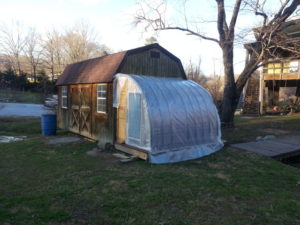
A simple poly-skinned enclosure makes a good all-season environment with addition of extruded polystyrene insulation
pH levels are ideal in a range between 6.5 and 7.5. Digestion problems usually present as a drop in pH, which “sours” the system. The condition is easily corrected with a dose of sodium bicarbonate (baking soda) or sodium carbonate (washing soda). Infrequent alkaline conditions are remedied with an application of common citric or lactic acid.
The C/N ratio directly affects gas potential and undesirable ammonia production. Carbon to Nitrogen ratios between 25:1 and 30:1 have proven to be ideal. Keeping the C/N ratio in check is a matter of calculating, by weight, the values of individual inputs to the substrate used as digester feed, which are available online at sources such as this homesteading site. Most livestock manures are already in the desirable range (poultry being one exception), so you’ll mostly be paying attention to supplemental garden and kitchen wastes.
The suitability of a substrate or feedstock for digestion depends not only on C/N ratios and pH levels, but also on the amount of total and volatile solids in the material. Livestock manures are usually in a slurry form with a limited dry matter content, but our horse manure required mixing with water to achieve a slurry. Too much dilution reduces the volume of manure input and too much dry matter can cause operating difficulties.
To activate the system a starter manure slurry of 8 to 10% total tank volume is introduced into the digestion chamber, where it takes 10 to 21 days to digest and start producing gas. Suitable manures include horse, cow, sheep, swine, rabbit, goat, poultry (with caveats) and others, but manure is not necessary to keep the system going once gas is being produced. Vegetables, fruits, kitchen and dairy products, fats, meat scraps, seeds, and eggshells are all fair game feedstocks at this point, though manures can continue as part of the matrix if it’s available.
This, in fact, was a lesson I learned with the original methane digester years ago. Committing to one substrate limits the collective value of having a digester on the homestead that, in fact, is equipped to consume almost anything. Though it’s convenient to have a consistent feed regimen, you are limiting the digester’s potential if you don’t consider all inputs, including rotten and molded foods. Food waste has a high energy potential because it has not been digested by the stomach of an animal—particularly foods high in calories, starch, and sugars.
As far as volume, our 300-gallon system can accept up to 2 gallons of food and garden waste a day, or 4 gallons of manure slurry, including dog and cat wastes. Any input should be free of soil, straw, and non-digestable materials such as stones and twigs.
Other acceptable substrate materials, to be considered on a limited basis, include citrus (it has anti-bacterial oils), oil and cooking grease, poultry manure (high ammonia levels), fish, and spinach. Materials to avoid would be cardboard, tissue paper, fur and feathers, coffee grounds, sawdust and wood chips.
What to Expect from Biogas Digestion
The 300-gallon capacity turnkey system on our farm is one of many existing designs, and though it’s convenient it is also relatively small because it was intended for use on a home scale. The gas storage bag has a 24 sq. ft. capacity which is the equivalent of about 4.5 kWh of energy, or just about 15,000 Btu.
Additional storage can be added, but the gas is difficult to compress and the technology impractical at this scale, so reinforced bladders are the storage of choice. With a moderate daily feeding of 2 lbs. of food scraps you can expect about 20 cu. ft. of gas daily under ideal conditions. Larger managed permanent systems perform even better, with some producing 1 cu. ft. of gas per day for every cubic foot of digester capacity.
In working with a flammable gas, safety of the system is always important. Though methane content of the gas will fluctuate slightly with digester conditions, biogas is essentially odorless, colorless, and lighter than air so it is difficult to detect. It is also an asphyxiant, like natural gas and propane. Its flame often burns with complete clarity so it may not be visible.
Maintenance is an occasional thing, but nonetheless important. Any leaks in the digester tank or liquid fittings need to be addressed promptly for sanitary reasons as well as performance. Gas leaks are critically essential to avoid, but since the system works at a very low pressure of 4” water column—about 0.15 psi—they are not particularly forceful and easy to detect using a liquid soap-water mix at the joints. We have never experienced a leak.
At some point the solids collect in the digester tank to the level where they must be removed. In this case, the liquid is siphoned or pumped out and the solids extracted through the port built into the base of the tank. The chamber is small and manageable enough that this is simply a chore and not a battle.
Granted, most of us probably will not be going to the lengths that Mr. Bate did to get his vehicle running on manure gas, but a regular supply of site-made biogas fuel isn’t beyond the capacity of anyone with a small farm or homestead. And yes, outside of cooking, lighting, and heating water, it is possible to power a stationary generator that would normally run on gasoline or LP with biogas fuel as long as it is cleaned and filtered properly, once fuel system modifications are made. The issue is not technical but more of a supply question, since one gallon of gasoline is the equivalent of 200 cubic feet of biogas.


